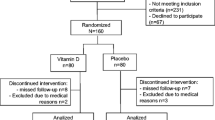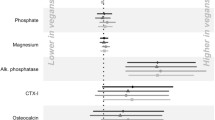Abstract
Iron-deficiency anaemia (IDA), one of the most common and widespread health disorders worldwide, affects fundamental metabolic functions and has been associated with deleterious effects on bone. Our aim was to know whether there are differences in bone remodelling between a group of premenopausal IDA women and a healthy group, and whether recovery of iron status has an effect on bone turnover markers. Thirty-five IDA women and 38 healthy women (control group) were recruited throughout the year. IDA women received pharmacological iron treatment. Iron biomarkers, aminoterminal telopeptide of collagen I (NTx), procollagen type 1 N-terminal propeptide (P1NP), 25-hydroxyvitamin D, and parathormone (PTH) were determined at baseline for both groups and after treatment with pharmacological iron for the IDA group. IDA subjects were classified as recovered (R) or non-recovered (nR) from IDA after treatment. NTx levels were significantly higher (p <0.001), and P1NP levels tended to be lower in IDA women than controls after adjusting for age and body mass index (BMI), with no differences in 25-hydroxyvitamin D or PTH. After treatment, the R group had significantly lower NTx and P1NP levels compared to baseline (p <0.05 and p <0.001 respectively), whilst no significant changes were seen in the nR group. No changes were seen in 25-hydroxyvitamin D or PTH for either group. IDA is related to higher bone resorption independent of age and BMI. Recovery from IDA has a concomitant beneficial effect on bone remodelling in premenopausal women, decreasing both bone resorption and formation.
Similar content being viewed by others
References
Adami S, Bianchi G, Brandi ML, Giannini S, Ortolani S, DiMunno O, Frediani B, Rossini M (2008) Determinants of bone turnover markers in healthy premenopausal women. Calcified Tissue Int 82:341–7
Ardawi M-SM, Maimani AA, Bahksh TA, Rouzi AA, Qari MH, Raddadi RM (2010) Reference intervals of biochemical bone turnover markers for Saudi Arabian women: a cross-sectional study. Bone 47:804–14
Arnett TR, Gibbons DC, Utting JC, Orriss IR, Hoebertz A, Rosendaal M, Meghji S (2003) Hypoxia is a major stimulator of osteoclast formation and bone resorption. J Cell Physiol 196:2–8
Bendich A (2010) Iron deficiency and overload. From basic biology to clinical medicine. Humana, NY. ISBN 978-1-934115-22-0
Blanco-Rojo R, Pérez-Granados AM, Toxqui L, Zazo P, De la Piedra C, Vaquero MP (2013) Relationship between vitamin D deficiency, bone remodelling and iron status in iron-deficient young women consuming an iron-fortified food. Eur J Nutr 52:695–703
Cesari M, Pahor M, Lauretani F et al (2005) Bone density and hemoglobin levels in older persons: results from the InCHIANTI study. Osteoporosis Int 16:691–9
D’Amelio P, Cristofaro MA, Tamone C et al (2008) Role of iron metabolism and oxidative damage in postmenopausal bone loss. Bone 43:1010–5
De Papp AE, Bone HG, Caulfield MP, Kagan R, Buinewicz A, Chen E, Rosenberg E, Reitz RE (2007) A cross-sectional study of bone turnover markers in healthy premenopausal women. Bone 40:1222–30
Del Campo MT, González-Casaus ML, Aguado P, Bernad M, Carrera F, Martínez ME (1999) Effects of age, menopause and osteoporosis on free, peptide-bound and total pyridinium crosslink excretion. Osteoporosis Int 9:449–54
Díaz-Castro J, López-Frías MR, Campos MS, López-Frías M, Alférez MJM, Nestares T, Ojeda ML, López-Aliaga I (2012) Severe nutritional iron-deficiency anaemia has a negative effect on some bone turnover biomarkers in rats. Eur J Nutr 51:241–7
Fujimoto H, Fujimoto K, Ueda A, Ohata M (1999) Hypoxemia is a risk factor for bone mass loss. J Bone Miner Metab 17:211–6
Glover SJ, Gall M, Schoenborn-Kellenberger O, Wagener M, Garnero P, Boonen S, Cauley JA, Black DM, Delmas PD, Eastell R (2009) Establishing a reference interval for bone turnover markers in 637 healthy, young, premenopausal women from the United Kingdom, France, Belgium, and the United States. J Bone Miner Res 24:389–97
Groba M, Miravalle A, Gonzalez Rodriguez E, García Santana S, Gonzalez Padilla E, Saavedra P, Soria A, Sosa M (2010) Factors related to vitamin D deficiency in medical students in Gran Canaria. Rev Osteoporos Metab Miner 2:11–18
Harris MM, Houtkooper LB, Stanford VA, Parkhill C, Weber JL, Flint-Wagner H, Weiss L, Going SB, Lohman TG (2003) Dietary iron is associated with bone mineral density in healthy postmenopausal women. J Nutr 133:3598–602
Heaney RP (2003) Is the paradigm shifting? Bone 33:457–65
Hercberg S, Preziosi P, Galan P (2001) Iron deficiency in Europe. Public Health Nutr 4:537–45
Holick MF, Chen TC (2008) Vitamin D deficiency: a worldwide problem with health consequences. Am J Clin Nutr 87:1080S–6S
Ilich-Ernst JZ, McKenna AA, Badenhop NE, Clairmont AC, Andon MB, Nahhas RW, Goel P, Matkovic V (1998) Iron status, menarche, and calcium supplementation in adolescent girls. Am J Clin Nutr 68:880–7
Jelkmann W (2011) Regulation of erythropoietin production. J Physiol 589:1251–8
Katsumata S, Katsumata-Tsuboi R, Uehara M, Suzuki K (2009) Severe iron deficiency decreases both bone formation and bone resorption in rats. J Nutr 139:238–243
Katsumata S, Tsuboi R, Uehara M, Suzuki K (2006) Dietary iron deficiency decreases serum osteocalcin concentration and bone mineral density in rats. Biosci Biotec Bioch 70:2547–2550
Knott L, Bailey AJ (1998) Collagen cross-links in mineralizing tissues: a review of their chemistry, function, and clinical relevance. Bone 22:181–7
McLean E, Cogswell M, Egli I, Wojdyla D, De Benoist B (2009) Worldwide prevalence of anaemia, WHO vitamin and mineral nutrition information system, 1993–2005. Public Health Nutr 12:444–54
Medeiros DM, Plattner A, Jennings D, Stoecker B (2002) Bone morphology, strength and density are compromised in iron-deficient rats and exacerbated by calcium restriction. J Nutr 132:3135–41
Medeiros DM, Stoecker B, Plattner A, Jennings D, Haub M (2004) Iron deficiency negatively affects vertebrae and femurs of rats independently of energy intake and body weight. J Nutr 134:3061–7
Parelman M, Stoecker B, Baker A, Medeiros D (2006) Iron restriction negatively affects bone in female rats and mineralization of hFOB osteoblast cells. Exp Biol Med 231:378–86
Rodríguez Sangrador M, Beltrán de Miguel B, Cuadrado Vives C, Moreiras Tuny O (2010) Influence of sun exposure and diet to the nutritional status of vitamin D in adolescent Spanish women: the five countries study (OPTIFORD Project). Nutr Hosp 25:755–62
Schulze KJ, Dreyfuss ML (2005) Iron-Deficiency Anemia. In: Caballero B (ed) Encyclopedia of human nutrition, 2nd edn. Elsevier, Oxford, pp 101–109
Scientific Advisory Committee on Nutrition (2010) Iron and health. TSO, London
Seeman E (2003) Invited review: pathogenesis of osteoporosis. J Appl Physiol 95:2142–51
Shin JY, Shim JY (2013) Low vitamin D levels increase anemia risk in Korean women. Clin Chim Acta 421:177–180
Shiozawa Y, Jung Y, Ziegler AM et al (2010) Erythropoietin couples hematopoiesis with bone formation. PLoS One 5:e10853
Sim JJ, Lac PT, Liu IL, Meguerditchian SO, Kumar VA, Kujubu DA, Rasgon SA (2010) Vitamin D deficiency and anemia: a cross-sectional study. Ann Haematol 89:447–52
Toxqui L, Pérez-Granados A, Blanco-Rojo R, Wright I, González-Vizcayno C, Vaquero MP (2013) Intake of an iron or iron and vitamin D-fortified skimmed milk and iron metabolism in women. Ann Nutr Metab (in press)
Tuderman L, Myllylä R, Kivirikko KI (1977) Mechanism of the prolyl hydroxylase reaction. 1. Role of co-substrates. Eur J Biochem 80:341–8
Watts NB (1999) Clinical utility of biochemical markers of bone remodeling. Clin Chem 45:1359–68
World Health Organisation (2004) Assessing the iron status of populations: including literature reviews: report of a Joint World Health Organization/Centers for Disease Control and Prevention Technical Consultation on the assessment of iron status at the population level. WHO, Geneva
Acknowledgments
This study was financed by Project AGL2009-11437. RBR and LT were supported by a JAE pre-doc grant from CSIC and European Social Fund. The authors are grateful to the volunteers who participated in the study, and to the staff of the anaemia section at Complejo Hospitalario de Toledo.
Conflict of interest
The authors have declared no conflict of interest.
Author information
Authors and Affiliations
Corresponding author
Rights and permissions
About this article
Cite this article
Wright, I., Blanco-Rojo, R., Fernández, M.C. et al. Bone remodelling is reduced by recovery from iron-deficiency anaemia in premenopausal women. J Physiol Biochem 69, 889–896 (2013). https://doi.org/10.1007/s13105-013-0266-3
Received:
Accepted:
Published:
Issue Date:
DOI: https://doi.org/10.1007/s13105-013-0266-3




